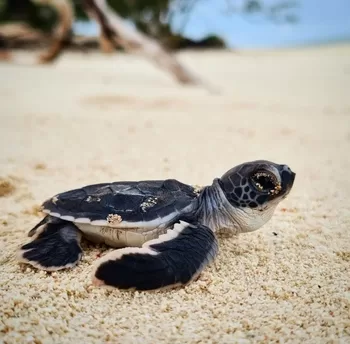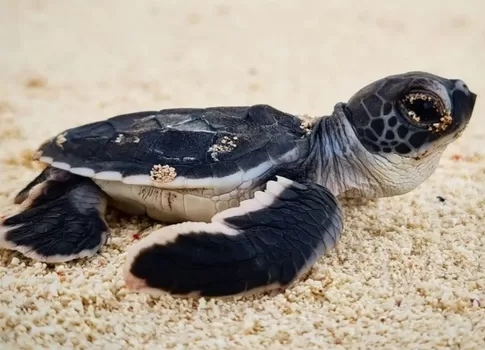Backpacks on Green Sea Turtle Hatchlings Unveil Elusive Behavior: UNSW Research Breakthrough
Scientists at UNSW Sydney have made significant strides in understanding the previously elusive behavior of green turtle hatchlings during the critical period between hatching and emerging from the sand. This research, recently published in Proceedings B, suggests that turtle hatchlings “swim” to the surface of the sand, a discovery that has broad implications for sea turtle conservation worldwide. Led by PhD student Davey Dor and supported by Associate Professor Lisa Schwanz and Dr. David Booth from the University of Queensland, this study marks a major shift in how we perceive the journey of these vulnerable creatures.
A New Perspective on Hatchling Movement
Until now, the process of turtle hatchlings emerging from their nests has remained largely a mystery, due to the challenges of studying behavior that occurs underground. Sea turtle nests are typically buried 30 to 80 centimeters deep, and hatchlings take anywhere from three to seven days to reach the surface. While the iconic image of baby turtles scurrying across the sand toward the ocean is familiar to many, the phase that occurs before their dramatic emergence has been almost entirely hidden from view—until now.
“Once the turtles are hatched, they somehow know to orient themselves upwards, even though they’re in complete darkness,” explains Mr. Dor. “We’ve always assumed they dig, but our findings suggest a more complex process where they rock back and forth, moving vertically through the sand as though they’re swimming.”
Using innovative miniature accelerometers, Dor and his team revealed that hatchlings maintain a head-up position throughout their journey to the surface. The data collected from these devices, which measure changes in movement, indicated that the hatchlings move more like swimmers than diggers—a discovery that upends long-standing assumptions.
Breaking New Ground in Turtle Conservation
For decades, biologists have struggled to understand how hatchlings navigate their way through sand, often relying on rudimentary techniques such as glass viewing panes or microphones to observe or listen to their movement. However, these methods have had limitations, leaving many questions unanswered. “It’s incredible to think about the amount of work these tiny hatchlings are doing to reach the surface in the dark, all while low on oxygen,” says A/Prof. Schwanz.
By attaching small accelerometer “backpacks” to turtle hatchlings, the researchers were able to capture invaluable data about their movement. The accelerometers used in this research, previously applied to studying animal behavior, have now been used to monitor hatchlings for the first time in this specific context.
This novel approach was tested on Heron Island, a key nesting site for green turtles in the southern Great Barrier Reef. The research team monitored 10 nests during the peak of nesting season, which runs from December to March. After waiting for the eggs to develop, the team attached lightweight accelerometers to selected hatchlings just before they made their journey to the surface.
The data collected shed light on the consistency of the hatchlings’ head-up orientation and revealed that their movement periods were short and closely tied to nighttime. These insights provide a better understanding of the process, and they open the door for further investigation into how environmental conditions might influence hatchling success.
The Impact on Conservation Efforts
With sea turtle populations in decline worldwide, this research comes at a crucial time for conservation. Several turtle species are endangered, and the nesting phase of their life cycle presents a significant vulnerability. As a result, conservation efforts have often focused on protecting nests through various interventions, including relocating nests to safer areas, shading nests to prevent overheating, and even watering nests to maintain humidity levels.
However, as Mr. Dor highlights, altering nest conditions such as moisture and temperature could have unforeseen consequences. “Factors like substrate moisture and depth, when altered, could impact hatchlings in ways we don’t fully understand yet,” he notes. “This is why understanding their behavior in the sand column is essential to improving conservation practices.”
One of the key issues identified in this research is that many hatchlings never even reach the surface, meaning that conservation strategies aimed at protecting them once they emerge may be too late for some. “We know that hatchlings are at great risk from predators when they cross the sand to the ocean,” adds A/Prof. Schwanz. “But this research shows us that some don’t even make it that far, and we need to figure out why.”
Opening Doors to Future Research
The use of accelerometers to track hatchling behavior offers numerous benefits, including the ability to gather precise data on movement, speed, and orientation during a period when direct observation is impossible. These insights could ultimately inform conservation efforts around the world, helping to optimize nest interventions to give more hatchlings a fighting chance.
“There are many factors we still don’t fully understand, but this new methodology will allow us to explore them,” says Mr. Dor. In fact, the study has already paved the way for further research. The following summer, the research team returned to Heron Island to deploy accelerometers on multiple hatchlings in a single nest, hoping to answer even more questions about turtle behavior. “There’s a theory that hatchlings may coordinate their movements, or even that there could be a division of labor among them,” says A/Prof. Schwanz. “Next year’s data will help us explore these fascinating possibilities.”
By breaking new ground in our understanding of turtle hatchling behavior, this research not only offers a glimpse into the early life of one of the world’s most endangered creatures but also provides crucial information that could shape the future of turtle conservation. As scientists continue to unravel the mysteries of these tiny swimmers, one thing is clear: the future of sea turtles may be a little brighter, thanks to a few tiny backpacks.
The Path Forward
The findings from this research mark a significant leap forward in understanding sea turtle hatchlings’ behavior and highlight the importance of adopting innovative technologies for conservation. With accelerating climate change threatening turtle populations worldwide, insights like these can help guide more effective, targeted conservation measures.
As the research continues to unfold, UNSW scientists remain hopeful that their work will not only lead to further discoveries but also inspire global conservation efforts to protect these majestic creatures in their earliest—and most vulnerable—moments.
Advertisement:

The Green Sea Turtle (Chelonia mydas) is one of the largest and most widespread sea turtle species, known for its gentle nature and important role in marine ecosystems. Let’s delve deeper into their size, population status, and migratory behavior.
Size and Characteristics
- Adult Size: Green sea turtles can grow to impressive sizes. Adults typically measure between 1 and 1.5 meters (3 to 5 feet) in length. They can weigh between 150 and 200 kilograms (330 to 440 pounds), though some individuals may weigh more.
- Appearance: Green turtles are named not for the color of their shell, which is usually olive to dark brown, but for the greenish color of their body fat. This distinctive coloration comes from their herbivorous diet as adults, which mainly consists of seagrass and algae.
- Lifespan: Green sea turtles can live for up to 70 years, though it takes around 20 to 50 years for them to reach sexual maturity.
Current Population Status
Green sea turtles are listed as endangered by the International Union for Conservation of Nature (IUCN), although their population varies by region. Globally, there are an estimated 85,000 to 90,000 nesting females left, but the numbers fluctuate depending on specific nesting beaches and regions.
The main threats facing green sea turtles are habitat loss due to coastal development, bycatch (accidental capture in fishing gear), climate change, and illegal poaching of their eggs, meat, and shells.
Migratory Patterns
Green sea turtles are highly migratory creatures, traveling vast distances between their feeding and nesting sites. Their migratory behavior is driven by the need to find food and to return to specific beaches for nesting, often the same beaches where they were born (a behavior known as natal homing).
Nesting to Feeding Migrations
Green sea turtles are known for their long migrations between foraging grounds and nesting beaches. They nest on tropical and subtropical beaches in over 80 countries, including key locations like the Great Barrier Reef in Australia, the Caribbean, and parts of the Pacific and Indian Oceans.
After laying eggs, adult female green turtles travel to coastal foraging grounds, where they feed primarily on seagrass and algae. These feeding grounds can be located hundreds, or even thousands, of kilometers away from their nesting sites. For example, some green sea turtles that nest in the southern Great Barrier Reef may migrate over 2,600 kilometers (about 1,600 miles) to feeding grounds off the coast of Indonesia or New Caledonia.
Juvenile Dispersal and the “Lost Years”
Once green turtle hatchlings make it to the ocean, they enter what scientists call the “lost years” phase. During this time, juvenile turtles disappear into the open ocean for several years. They drift along ocean currents, feeding on small invertebrates and algae as they grow. Juvenile turtles remain in the pelagic zone (open ocean) until they are large enough to return to coastal areas to continue feeding and maturing.
Seasonal Migrations
Green sea turtles may migrate seasonally to follow warm water and abundant food supplies. As cold-blooded animals, they rely on warm water to regulate their body temperature, so they often travel to more tropical regions during colder months.
Nesting Behavior
Green turtles typically return to their natal beach (the beach where they were born) to nest. Females lay their eggs in shallow nests dug in the sand, usually at night. The nesting season varies by region but often occurs between June and September in many parts of the world. A single female can lay up to 100-150 eggs per nest, and she may nest several times during a single season, with each clutch laid around two weeks apart.
After an incubation period of around 60 days, the hatchlings emerge and instinctively make their way to the sea. Unfortunately, this journey is perilous, as they are vulnerable to predators like crabs, birds, and fish.
Threats During Migration
During their extensive migrations, green turtles face numerous threats:
- Bycatch: Green turtles often become entangled in fishing gear like trawl nets and longlines, which can result in injury or death.
- Climate Change: Rising sea temperatures can affect the turtles’ feeding grounds and disrupt their migratory patterns. Warmer sands also affect hatchling sex ratios (warmer sands produce more females).
- Habitat Loss: Coastal development and erosion of nesting beaches threaten green turtles’ breeding grounds.
- Pollution: Plastic debris in the ocean can be mistaken for food, causing blockages in turtles’ digestive systems.
Conservation Efforts
Several conservation programs are dedicated to protecting green sea turtles and ensuring their survival. These efforts include:
- Protected Nesting Beaches: Many important nesting sites are now protected, and conservation groups often monitor nests to prevent poaching and predation.
- Bycatch Reduction: Fishing gear modifications, such as Turtle Excluder Devices (TEDs), have been developed to allow turtles to escape from fishing nets.
- Marine Protected Areas (MPAs): MPAs help safeguard vital feeding grounds and migratory routes.
- Public Awareness Campaigns: These initiatives aim to reduce plastic waste, promote sustainable fishing practices, and raise awareness about the importance of conserving sea turtle populations.
By better understanding the green sea turtle’s migratory patterns and challenges, scientists and conservationists can work more effectively to protect these ancient and iconic marine creatures.
Related stories
Photographer Frank Hurley on the Great Barrier Reef future
Lobbying saves Great Barrier Reef from World Heritage listing
Scuba Diving on the Woodburn wreck, Suva, Fiji
The Ultimate Guide to Keeping a Saltwater Aquarium
8 animals & 5 plants added to Threatened Species this month
RFS Firefighters Unite North America and Australasia
Mistake State Forest: A Battle for Preservation
Targeted Logging Threatens Great Koala National Park
Murray Darling Basin Water Markets Lose $2 Billion
Advertisement:




